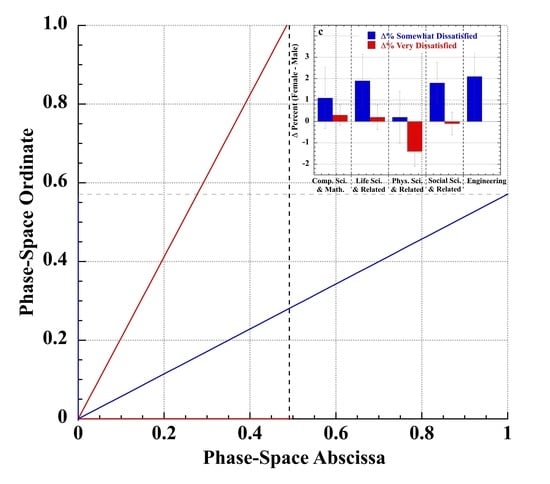Falsification of the Sexual Experiences Questionnaire: No Evidence of Systemic Sexual Harassment in Academic STEM
Abstract
1. Introduction
2. Results
2.1. NAS Methodology, Data, and Literature
2.2. The RTI Survey
2.2.1. Survey Overview
2.2.2. Evidence from Workplace Job Satisfaction
2.2.3. Trends
2.3. The CLASE Survey
2.4. The Sexual Experiences Questionnaire (SEQ)
2.4.1. The SEQ Criterion Conundrum
2.4.2. SEQ Experiences, Stress, and Personality
2.4.3. The SEQ and Subjective Methodological Choices
2.4.4. The SEQ as a Measure of Sexual Harassment
2.4.5. On Psychometry
2.4.6. Major Criticisms by Gutek and Associates
- only modest reliability and validity.
- over-reporting the prevalence of sexual harassment.
- over-estimating the gap between the experiences of harassment and the labeling of harassment.
- under-estimating the rate of sexual harassment reporting.
- distorting the type and distribution of responses to harassment.
- overly broad definitions of sexual harassment, which distort findings.
- inadequate test-retest metrics.
2.4.7. The SEQ Factors Are Correlated
2.5. Correlation and the Meaning of SEQ Factors
2.5.1. Statistical Independence
2.5.2. Correlation Geometry and the Absence of Meaning
2.6. Evolutionary Psychology, Personality, and the Incidence of Serial Offenders
2.6.1. Enter HEXACO Emotionality
2.6.2. The Evolutionary Psychology of SH
- Job satisfaction statistics of female academics contradict the notion of systemic sexual harassment in academic STEM.
- SEQ instrumentality presumes the indistinguishable female.
- SEQ methodology is subjective and lacks predictive power.
- The SEQ is ambiguous and neither measures nor diagnoses SH.
- The SEQ CLASE study cannot substantiate a culture of SH in academic STEM.
- The abuse of generalizing statistics falsely indicts an entire class.
- Evolutionary psychology provides explanatory power.
3. Discussion
3.1. Representation and Reality
3.2. Qualitative Meaning and Inferential Modesty
3.3. The SEQ and Its Sociology
3.3.1. An Inadequacy of Study: Causality
3.3.2. An Inadequacy of Study: Summary Diagnosis
3.3.3. An Inadequacy of Study and Its Consequences
Generalizing to Defamation
Misreading about Rape
3.4. The NAS Report and the EEOC Definition of Sexual Harassment
3.5. Limitations of This Work
3.6. Future Research Directions in Evolutionary Psychology
Supplementary Materials
Funding
Institutional Review Board Statement
Informed Consent Statement
Data Availability Statement
Acknowledgments
Conflicts of Interest
Appendix A
Appendix A.1. On the Participant Counts in Schneider & assoc. and in Magley & assoc.
Appendix A.2. On the Participation Count of Magley & associates
References
- Gutek, B.A.; Murphy, R.O.; Douma, B. A Review and Critique of the Sexual Experiences Questionnaire (SEQ). Law Hum. Behav. 2004, 28, 457–482. [Google Scholar] [CrossRef] [PubMed]
- Goodman-Delahunty, J. Pragmatic Support for the Reasonable Victim Standard in Hostile Workplace Sexual Harassment Cases. Psychol. Public Policy Law 1999, 5, 519–555. [Google Scholar] [CrossRef]
- Isbell, L.M.; Swedish, K.; Gazan, D.B. Who Says It’s Sexual Harassment? The Effects of Gender and Likelihood to Sexually Harass on Legal Judgments of Sexual Harassment. J. Appl. Soc. Psychol. 2005, 35, 745–772. [Google Scholar] [CrossRef]
- Juliano, A.; Schwab, S.J. The Sweep of Sexual Harassment Cases. Cornell Law Rev. 2001, 86, 548–602. [Google Scholar]
- York, K.M.; Brookhouse, K.J. The Legal History of Work-Related Sexual Harassment and Implications for Employers. Empl. Responsib. Rights J. 1988, 1, 227–237. [Google Scholar] [CrossRef]
- National Academies of Sciences, Engineering, and Medicine. Sexual Harassment of Women: Climate, Culture, and Consequences in Academic Sciences, Engineering, and Medicine; The National Academies Press: Washington, DC, USA, 2018. [Google Scholar]
- Lindquist, C.; McKay, T. Sexual Harassment Experiences and Consequences for Women Faculty in Science, Engineering, and Medicine; Research Triangle Institute: Research Triangle Park, NC, USA, 2018. [Google Scholar]
- Hutagalung, F.; Ishak, Z. Sexual Harassment: A Predictor to Job Satisfaction and Work Stress among Women Employees. Procedia-Soc. Behav. Sci. 2012, 65, 723–730. [Google Scholar] [CrossRef]
- Willness, C.R.; Steel, P.; Lee, K. A meta-analysis of the antecedents and consequences of workplace sexual harassment. Pers. Psychol. 2007, 60, 127–162. [Google Scholar] [CrossRef]
- Malik, N.I.; Malik, S.; Qureshi, N.; Atta, M. Sexual Harassment as Predictor of Low Self Esteem and Job Satisfaction among in-Training Nurses. FWU J. Soc. Sci. 2014, 8, 107–116. [Google Scholar]
- Rubin, M.; Paolini, S.; Subašić, E.; Giacomini, A. A Confirmatory Study of the Relations between Workplace Sexism, Sense of Belonging, Mental Health, and Job Satisfaction among Women in Male-Dominated Industries. J. Appl. Soc. Psychol. 2019, 49, 267–282. [Google Scholar] [CrossRef]
- Schneider, K.T.; Swan, S.; Fitzgerald, L.F. Job-Related and Psychological Effects of Sexual Harassment in the Workplace: Empirical Evidence from Two Organizations. J. Appl. Psychol. 1997, 82, 401–415. [Google Scholar] [CrossRef]
- Fitzgerald, L.F.; Drasgow, F.; Hulin, C.L.; Gelfand, M.J.; Magley, V.J. Antecedents and consequences of sexual harassment in organizations: A test of an integrated model. J. Appl. Psychol. 1997, 82, 578–589. [Google Scholar] [CrossRef] [PubMed]
- Fitzgerald, L.F.; Cortina, L.M. Sexual Harassment in Work Organizations: A View from the 21st Century. In Apa Handbook of the Psychology of Women: Perspectives on Women’s Private and Public Lives; American Psychological Association: Washington, DC, USA, 2018; Volume 2, pp. 214–234. [Google Scholar]
- Siuta, R.L.; Bergman, M.E. Sexual Harassment in the Workplace. In Oxford Research Encyclopedias Business and Management; Oxford University Press: Oxford, UK, 2019. [Google Scholar]
- Magley, V.J.; Hulin, C.L.; Fitzgerald, L.F.; DeNardo, M. Outcomes of self-labeling sexual harassment. J. Appl. Psychol. 1999, 84, 390–402. [Google Scholar] [CrossRef] [PubMed]
- Munson, L.J.; Miner, A.G.; Hulin, C. Labeling sexual harassment in the military: An extension and replication. J. Appl. Psychol. 2001, 86, 293–303. [Google Scholar] [CrossRef]
- Berdahl, J.L.; Aquino, K. Sexual Behavior at Work: Fun or Folly? J. Appl. Psychol. 2009, 94, 34–47. [Google Scholar] [CrossRef] [PubMed]
- Jones, J.I. An Overview of Employment and Wages in Science, Technology, Engineering, and Math (Stem) Groups. In Beyond the Numbers: Employment & Unemployment; Bureau of Labor Statistics: Washington, DC, USA, 2014. [Google Scholar]
- Foley, D.J.; Selfa, L.A.; Grigorian, K.H. Number of Women with U.S. Doctorates in Science, Engineering, or Health Employed in the United States More Than Doubles since 1997. In InfoBrief; National Center for Science and Engineering Statistics: Washington, DC, USA, 2019; pp. 1–7. [Google Scholar]
- Ceci, S.J.; Ginther, D.K.; Kahn, S.; Williams, W.M. Women in Academic Science:A Changing Landscape. Psychol. Sci. Public Interest 2014, 15, 75–141. [Google Scholar] [CrossRef] [PubMed]
- Fitzgerald, L.F.; Shullman, S.L.; Bailey, N.; Richards, M.; Swecker, J.; Gold, Y.; Ormerod, M.; Weitzman, L. The incidence and dimensions of sexual harassment in academia and the workplace. J. Vocat. Behav. 1988, 32, 152–175. [Google Scholar] [CrossRef]
- National Research Council. Gender Differences at Critical Transitions in the Careers of Science, Engineering, and Mathematics Faculty; The National Academies Press: Washington, DC, USA, 2010. [Google Scholar]
- Fitzgerald, L.F. Sexual Harassment: Violence against Women in the Workplace. Am. Psychol. 1993, 48, 1070–1076. [Google Scholar] [CrossRef]
- Fitzgerald, L.F.; Gelfand, M.J.; Drasgow, F. Measuring Sexual Harassment: Theoretical and Psychometric Advances. Basic Appl. Soc. Psychol. 1995, 17, 425–445. [Google Scholar] [CrossRef]
- Gelfand, M.J.; Fitzgerald, L.F.; Drasgow, F. The Structure of Sexual Harassment: A Confirmatory Analysis across Cultures and Settings. J. Vocat. Behav. 1995, 47, 164–177. [Google Scholar] [CrossRef]
- Cortina, L.; Berdahl, J. Sexual Harassment in Organizations: A Decade of Research in Review. In The Sage Handbook of Organizational Behavior: Volume 1 Micro Approaches; Barling, J., Cooper, C.L., Eds.; Sage: London, UK, 2008; pp. 469–497. [Google Scholar]
- Clancy, K.B.; Cortina, L.M.; Kirkland, A.R. Opinion: Use Science to Stop Sexual Harassment in Higher Education. Proc. Natl. Acad. Sci. USA 2020, 117, 22614. [Google Scholar] [CrossRef]
- Swartout, K.M.; Flack Jr, W.F.; Cook, S.L.; Olson, L.N.; Smith, P.H.; White, J.W. Measuring campus sexual misconduct and its context: The Administrator-Researcher Campus Climate Consortium (ARC3) survey. Psychol. Trauma: Theory Res. Pr. Policy 2019, 11, 495–504. [Google Scholar] [CrossRef] [PubMed]
- Cortina, L.M.; Swan, S.; Fitzgerald, L.F.; Waldo, C. Sexual Harassment and Assault: Chilling the Climate for Women in Academia. Psychol. Women Q. 1998, 22, 419–441. [Google Scholar] [CrossRef]
- Ilies, R.; Hauserman, N.; Schwochau, S.; Stibal, J. Reported incidence rates of work-related sexual harassment in the United States: Using meta-analysis to explain reported rate disparities. Pers. Psychol. 2003, 56, 607–631. [Google Scholar] [CrossRef]
- Magley, V.J.; Shupe, E.I. Self-Labeling Sexual Harassment. Sex Roles 2005, 53, 173–189. [Google Scholar] [CrossRef]
- Fitzgerald, L.F.; Magley, V.J.; Drasgow, F.; Waldo, C.R. Measuring Sexual Harassment in the Military: The Sexual Experiences Questionnaire (SEQ—DoD). Mil. Psychol. 1999, 11, 243–263. [Google Scholar] [CrossRef]
- Agarwal, R.; Barney, J.B.; Foss, N.J.; Klein, P.G. Heterogeneous resources and the financial crisis: Implications of strategic management theory. Strat. Organ. 2009, 7, 467–484. [Google Scholar] [CrossRef]
- Robertson, C.; Feick, R. Inference and analysis across spatial supports in the big data era: Uncertain point observations and geographic contexts. Trans. GIS 2018, 22, 455–476. [Google Scholar] [CrossRef]
- Antecol, H.; Cobb-Clark, D. The sexual harassment of female active-duty personnel: Effects on job satisfaction and intentions to remain in the military. J. Econ. Behav. Organ. 2006, 61, 55–80. [Google Scholar] [CrossRef]
- Kandler, C.; Papendick, M. 29—Behavior Genetics and Personality Development: A Methodological and Meta-Analytic Review. In Personality Development across the Lifespan; Specht, J., Ed.; Academic Press: Cambridge, MA, USA, 2017; pp. 473–495. [Google Scholar]
- de Vries, R.E.; Tybur, J.M.; Pollet, T.; van Vugt, M. Evolution, situational affordances, and the HEXACO model of personality. Ethol. Sociobiol. 2016, 37, 407–421. [Google Scholar] [CrossRef]
- Xin, Y.; Wu, J.; Yao, Z.; Guan, Q.; Aleman, A.; Luo, Y. The relationship between personality and the response to acute psychological stress. Sci. Rep. 2017, 7, 16906. [Google Scholar] [CrossRef]
- de la Fuente, J.; González-Torres, M.C.; Artuch-Garde, R.; Vera-Martínez, M.M.; Martínez-Vicente, J.M.; Peralta-S’Anchez, F.J. Resilience as a Buffering Variable Between the Big Five Components and Factors and Symptoms of Academic Stress at University. Front. Psychiatry 2021, 12, 600240. [Google Scholar] [CrossRef] [PubMed]
- Lecic-Tosevski, D.; Vukovic, O.; Stepanovic, J. Stress and Personality. Psychiatriki 2011, 22, 290–297. [Google Scholar] [PubMed]
- Dougall, A.L.; Herberman, H.B.; Delahanty, D.L.; Inslicht, S.S.; Baum, A. Similarity of Prior Trauma Exposure as a Determinant of Chronic Stress Responding to an Airline Disaster. J. Consult. Clin. Psychol. 2000, 68, 290–295. [Google Scholar] [CrossRef]
- Maguen, S.; Metzler, T.J.; McCaslin, S.E.; Inslicht, S.; Henn-Haase, C.; Neylan, T.C.; Marmar, C.R. Routine Work Environment Stress and PTSD Symptoms in Police Officers. J. Nerv. Ment. Dis. 2009, 197, 754–760. [Google Scholar] [CrossRef] [PubMed]
- Garfin, D.R.; Holman, E.A.; Silver, R.C. Exposure to prior negative life events and responses to the Boston marathon bombings. Psychol. Trauma Theory Res. Pract. Policy 2020, 12, 320–329. [Google Scholar] [CrossRef] [PubMed]
- Hay, M.S.; Elig, T.W. The 1995 Department of Defense Sexual Harassment Survey: Overview and Methodology. Mil. Psychol. 1999, 11, 233–242. [Google Scholar] [CrossRef]
- Mason, R.E.; Kavee, J.A.; Wheeless, S.C.; George, B.J.; Riemer, R.A.; Elig, T.W. The 1995 Armed Forces Sexual Harassment Survey: Statistical Methodology Report; Defense Manpower Data Center (DMDC), Survey & Program Evaluation Division: Arlington, VA, USA, 1996. [Google Scholar]
- Freedman, D.A. Statistical Models and Shoe Leather. In Statistical Models and Causal Inference: A Dialogue with the Social Sciences; Collier, D., Freedman, D.A., Sekhon, J.S., Stark, P.B., Eds.; Cambridge University Press: Cambridge, UK, 2009; pp. 45–62. [Google Scholar]
- Calabrese, E.J. Origin of the linearity no threshold (LNT) dose–response concept. Arch. Toxicol. 2013, 87, 1621–1633. [Google Scholar] [CrossRef]
- Calabrese, E.J. Obituary Notice: Lnt Dead at 89 Years, a Life in the Spotlight. Environ. Res. 2017, 155, 276–278. [Google Scholar] [CrossRef]
- Calabrese, E.J.; Golden, R.J. Why toxicologists resisted and radiation geneticists supported EPA’S adoption of LNT for cancer risk assessment. Chem. Interactions 2019, 310, 108736. [Google Scholar] [CrossRef]
- Gutek, B.A. How Can We Make Our Research on Sexual Harassment More Useful in Legal Decision Making? In Social Consciousness in Legal Decision Making: Psychological Perspectives; Wiener, R.L., Bornstein, B.H., Schopp, R., Willborn, S.L., Eds.; Springer: Boston, MA, USA, 2007; pp. 153–170. [Google Scholar]
- Foote, W.E. Sexual Harassment: What Forensic Clinical Psychologists Need from Social Scientists. Psychol. Inj. Law 2016, 9, 253–264. [Google Scholar] [CrossRef]
- Klein, L.B.; Martin, S.L. Sexual Harassment of College and University Students: A Systematic Review. Trauma Violence Abus. 2021, 22, 777–792. [Google Scholar] [CrossRef] [PubMed]
- Reddy, M.K.; Murdoch, M. Sex Differences in the Factor Structure of a Modified Sexual Experiences Questionnaire. Psychol. Rep. 2010, 107, 773–783. [Google Scholar] [CrossRef] [PubMed]
- Benjes-Small, C.; Knievel, J.; Hunter, J.; Wisecup, A.; Resor-Whicker, J. Quantifying the #Metoo Narrative: Incidence and Prevalence of Sexual Harassment in Academic Libraries. In Proceedings of the Association Of College & Research Libraries Conference, Cleveland, OH, USA, 10–13 April 2019. [Google Scholar]
- Berdahl, J.L.; Magley, V.J.; Waldo, C.R. The Sexual Harassment of Men? Exploring the Concept with Theory and Data. Psychol. Women Q. 1996, 20, 527–547. [Google Scholar] [CrossRef]
- Arvey, R.D.; Cavanaugh, M.A. Cavanaugh. Using Surveys to Assess the Prevalence of Sexual Harassment: Some Methodological Problems. J. Soc. Issues 1995, 51, 39–52. [Google Scholar] [CrossRef]
- Stark, S.; Chernyshenko, O.S.; Lancaster, A.R.; Drasgow, F.; Fitzgerald, L.F. Toward Standardized Measurement of Sexual Harassment: Shortening the SEQ-DoD Using Item Response Theory. Mil. Psychol. 2002, 14, 49–72. [Google Scholar] [CrossRef]
- Till, F.J. Sexual Harassment. A Report on the Sexual Harassment of Students; National Advisory Council on Women’s Educational Programs: Washington, DC, USA, 1980. [Google Scholar]
- Babyak, M. What You See May Not Be What You Get: A Brief, Nontechnical Introduction to Overfitting in Regression-Type Models. Psychosom Med. 2004, 66, 411–421. [Google Scholar]
- Hanley, J.A.; Negassa, A.; Edwardes, M.D.D.; Forrester, J.E. Statistical Analysis of Correlated Data Using Generalized Estimating Equations: An Orientation. Am. J. Epidemiol. 2003, 157, 364–375. [Google Scholar] [CrossRef]
- Yang, Y.; Remmers, E.F.; Ogunwole, C.B.; Kastner, D.L.; Gregersen, P.K.; Li, W. Effective Sample Size: Quick Estimation of the Effect of Related Samples in Genetic Case–Control Association Analyses. Comput. Biol. Chem. 2011, 35, 40–49. [Google Scholar] [CrossRef]
- Lee Rodgers, J.; Nicewander, W.A. Thirteen Ways to Look at the Correlation Coefficient. Am. Stat. 1988, 42, 59–66. [Google Scholar] [CrossRef]
- Lewis, G.J.; Bates, T.C. How Genes Influence Personality: Evidence from Multi-Facet Twin Analyses of the Hexaco Dimensions. J. Res. Personal. 2014, 51, 9–17. [Google Scholar] [CrossRef]
- Veselka, L.; Schermer, J.A.; Petrides, K.V.; Cherkas, L.F.; Spector, T.D.; Vernon, P.A. A General Factor of Personality: Evidence from the Hexaco Model and a Measure of Trait Emotional Intelligence. Twin Res. Hum. Genet. 2009, 12, 420–424. [Google Scholar] [CrossRef]
- Veselka, L.; Petrides, K.V.; Schermer, J.A.; Cherkas, L.F.; Spector, T.D.; Vernon, P.A. Phenotypic and Genetic Relations between the Hexaco Dimensions and Trait Emotional Intelligence. Twin Res. Hum. Genet. 2010, 13, 66–71. [Google Scholar] [CrossRef][Green Version]
- Kandler, C.; Richter, J.; Zapko-Willmes, A. The Nature and Nurture of HEXACO Personality Trait Differences. Z. Für Psychol. 2019, 227, 195–206. [Google Scholar] [CrossRef]
- Ashton, M.C.; Lee, K.; Perugini, M.; Szarota, P.; de Vries, R.E.; Di Blas, L.; Boies, K.; De Raad, B. A Six-Factor Structure of Personality-Descriptive Adjectives: Solutions From Psycholexical Studies in Seven Languages. J. Pers. Soc. Psychol. 2004, 86, 356–366. [Google Scholar] [CrossRef]
- Lee, K.; Ashton, M.C. Psychometric Properties of the Hexaco Personality Inventory. Multivar. Behav. Res. 2004, 39, 329–358. [Google Scholar] [CrossRef]
- Lee, K.; Ashton, M.C. Further Assessment of the Hexaco Personality Inventory: Two New Facet Scales and an Observer Report Form. Psychol. Assess. 2006, 18, 182–191. [Google Scholar] [CrossRef]
- Zettler, I.; Thielmann, I.; Hilbig, B.E.; Moshagen, M. The Nomological Net of the HEXACO Model of Personality: A Large-Scale Meta-Analytic Investigation. Perspect. Psychol. Sci. 2020, 15, 723–760. [Google Scholar] [CrossRef] [PubMed]
- Ashton, M.C.; Lee, K.; De Vries, R.E. The Hexaco Honesty-Humility, Agreeableness, and Emotionality Factors:A Review of Research and Theory. Personal. Soc. Psychol. Rev. 2014, 18, 139–152. [Google Scholar] [CrossRef] [PubMed]
- Krings, F.; Facchin, S. Organizational justice and men’s likelihood to sexually harass: The moderating role of sexism and personality. J. Appl. Psychol. 2009, 94, 501–510. [Google Scholar] [CrossRef]
- Pryor, J.B. Sexual harassment proclivities in men. Sex Roles 1987, 17, 269–290. [Google Scholar] [CrossRef]
- Pryor, J.B.; Stoller, L.M. Sexual Cognition Processes in Men High in the Likelihood to Sexually Harass. Personal. Soc. Psychol. Bull. 1994, 20, 163–169. [Google Scholar] [CrossRef]
- Ashton, M.C.; Lee, K. The prediction of Honesty–Humility-related criteria by the HEXACO and Five-Factor Models of personality. J. Res. Pers. 2008, 42, 1216–1228. [Google Scholar] [CrossRef]
- Lee, K.; Gizzarone, M.; Ashton, M.C. Personality and the Likelihood to Sexually Harass. Sex Roles 2003, 49, 59–69. [Google Scholar] [CrossRef]
- Ménard, K.S.; Shoss, N.E.; Pincus, A.L. Attachment and Personality Predicts Engagement in Sexual Harassment by Male and Female College Students. Violence Vict. 2010, 25, 770–786. [Google Scholar] [CrossRef]
- Koehn, M.A.; Okan, C.; Jonason, P.K. A Primer on the Dark Triad Traits. Aust. J. Psychol. 2019, 71, 7–15. [Google Scholar] [CrossRef]
- Jonason, P.K.; Girgis, M.; Milne-Home, J. The Exploitive Mating Strategy of the Dark Triad Traits: Tests of Rape-Enabling Attitudes. Arch. Sex. Behav. 2017, 46, 697–706. [Google Scholar] [CrossRef] [PubMed]
- Frank, P. Sexual Harassment, Sexual Abuse, and the Serial Offender Personality. 2022; to be submitted. [Google Scholar]
- McWhorter, S.K.; Stander, V.A.; Merrill, L.L.; Thomsen, C.J.; Milner, J.S. Reports of Rape Reperpetration by Newly Enlisted Male Navy Personnel. Violence Vict. 2009, 24, 204–218. [Google Scholar] [CrossRef]
- Lovell, R.; Butcher, F.; Flannery, D.J. Report on Serial and One-Time Sexual Offenders. In Cuyahoga County Sexual Assault Kit Pilot Project (SAK); Case Western Reserve University: Cleveland, OH, USA, 2016. [Google Scholar]
- Lovell, R.; Butcher, F.; Flannery, D.J.; Overman, L.; Walker, T. Patterns of Sexual Offending. In Cuyahoga County Sexual Assault Kit Pilot Research Project; Case Western Reserve University: Cleveland, OH, USA, 2016. [Google Scholar]
- Cantalupo, N.C.; Kidder, W.C. A Systematic Look at a Serial Problem: Sexual Harassment of Students by University Faculty. Utah Law Rev. 2018, 2018, 671–786. [Google Scholar]
- Gutek, B.A. Sex and the Workplace; Jossey-Bass: San Francisco, CA, USA, 1985. [Google Scholar]
- Driscoll, D.M.; Kelly, J.R.; Henderson, W.L. Can Perceivers Identify Likelihood to Sexually Harass? Sex Roles 1998, 38, 557–588. [Google Scholar] [CrossRef]
- Murphy, J.D.; Driscoll, D.M.; Kelly, J.R. Differences in the Nonverbal Behavior of Men Who Vary in the Likelihood to Sexually Harass. J. Soc. Behav. Personal. 1999, 14, 113–128. [Google Scholar]
- Ceci, S.J. Women in Academic Science: Experimental Findings From Hiring Studies. Educ. Psychol. 2018, 53, 22–41. [Google Scholar] [CrossRef]
- Cliff, N. Some Cautions Concerning The Application Of Causal Modeling Methods. Multivar. Behav. Res. 1983, 18, 115–126. [Google Scholar] [CrossRef] [PubMed]
- Mahoney, J. Beyond Correlational Analysis: Recent Innovations in Theory and Method. Sociol. Forum 2011, 16, 575–593. [Google Scholar] [CrossRef]
- Stewart, S.; Ivy, M.A.; Anslyn, E.V. The use of principal component analysis and discriminant analysis in differential sensing routines. Chem. Soc. Rev. 2014, 43, 70–84. [Google Scholar] [CrossRef] [PubMed]
- White, H. A Reality Check for Data Snooping. Econometrica 2000, 68, 1097–1126. [Google Scholar] [CrossRef]
- O’Brien, R.M. Comment: Some Challenges When Estimating the Impact of Model Uncertainty on Coefficient Instability. Sociol. Methodol. 2018, 48, 34–39. [Google Scholar] [CrossRef]
- Murphy, K.R.; Aguinis, H. Harking: How Badly Can Cherry-Picking and Question Trolling Produce Bias in Published Results? J. Bus. Psychol. 2019, 34, 1–17. [Google Scholar] [CrossRef]
- Fitzgerald, L.F.; Shullman, S. The Development and Validation of an Objectively Scored Measure of Sexual Harassment. In Proceedings of the Annual Meeting of the American Psychological Association, Los Angeles, CA, USA, 22–25 August 1985. [Google Scholar]
- Quick, J.C.; McFadyen, M. Sexual Harassment: Have We Made Any Progress? J. Occup. Health Psychol. 2017, 22, 286–298. [Google Scholar] [CrossRef]
- Lee, K.; Ashton, M.C.; Wiltshire, J.; Bourdage, J.S.; Visser, B.A.; Gallucci, A. Sex, Power, and Money: Prediction from the Dark Triad and Honesty–Humility. Eur. J. Personal. 2013, 27, 169–184. [Google Scholar] [CrossRef]
- Ashton, M.C.; Lee, K. The HEXACO Model of Personality Structure and the Importance of the H Factor. Soc. Pers. Psychol. Compass 2008, 2, 1952–1962. [Google Scholar] [CrossRef]
- Foubert, J.D.; Clark-Taylor, A.; Wall, A.F. Is Campus Rape Primarily a Serial or One-Time Problem? Evidence From a Multicampus Study. Violence Against Women 2020, 26, 296–311. [Google Scholar] [CrossRef] [PubMed]
- Swartout, K.M.; Flack, W.F., Jr. Campus Sexual Assault. In The Routledge International Handbook of Violence Studies; DeKeseredy, W.S., Rennison, C.M., Hall-Sanchez, A.K., Eds.; Routledge: London, UK, 2018; pp. 286–295. [Google Scholar]
- Swartout, K.M.; de Heer, B.A.; Thompson, M.P.; Zinzow, H.M.; Brennan, C.L. Chapter 18—A Cross-Disciplinary Review of Empirical Studies Addressing Repeat Versus Time-Limited Sexual Violence Perpetration. In Engaging Boys and Men in Sexual Assault Prevention; Orchowski, L.M., Berkowitz, A.D., Eds.; Academic Press: Cambridge, MA, USA, 2022; pp. 411–422. [Google Scholar]
- Dinić, B.M.; Wertag, A. Effects of Dark Triad and HEXACO traits on reactive/proactive aggression: Exploring the gender differences. Pers. Individ. Differ. 2018, 123, 44–49. [Google Scholar] [CrossRef]
- Jakobwitz, S.; Egan, V. The dark triad and normal personality traits. Pers. Individ. Differ. 2006, 40, 331–339. [Google Scholar] [CrossRef]
- Ashton, M.C.; Lee, K. The Dark Triad, the Big Five, and the Hexaco Model. Personal. Individ. Differ. 2014, 67, 2–5. [Google Scholar]
- Pailing, A.; Boon, J.; Egan, V. Personality, the Dark Triad and Violence. Personal. Individ. Differ. 2014, 67, 81–86. [Google Scholar] [CrossRef]
- Zeigler-Hill, V.; Besser, A.; Morag, J.; Campbell, W.K. The Dark Triad and Sexual Harassment Proclivity. Personal. Individ. Differ. 2016, 89, 47–54. [Google Scholar] [CrossRef]
- Cantalupo, N.C. Campus Violence: Understanding the Extraordinary through the Ordinary. J. Coll. Univ. Law 2009, 35, 613–690. [Google Scholar]
- Johnson, A.G. On the Prevalence of Rape in the United States. Signs J. Women Cult. Soc. 1980, 6, 136–146. [Google Scholar] [CrossRef]
- Koss, M.P.; Gidycz, C.A.; Wisniewski, N. The Scope of Rape: Incidence and Prevalence of Sexual Aggression and Victimization in a National Sample of Higher Education Students. J. Consult. Clin. Psychol. 1987, 55, 162–170. [Google Scholar] [CrossRef]
- Pascoe, C.J.; Hollander, J.A. Good Guys Don’t Rape: Gender, Domination, and Mobilizing Rape. Gend. Soc. 2015, 30, 67–79. [Google Scholar] [CrossRef]
- Pappas, S. Apa Issues First-Ever Guidelines for Practice with Men and Boys. Monit. Psychol. 2018, 50, 34. [Google Scholar]
- Bribiescas, R.G.; Ellison, P.T.; Gray, P.B. Male Life History, Reproductive Effort, and the Evolution of the Genus Homo: New Directions and Perspectives. Curr. Anthropol. 2012, 53, S424–S435. [Google Scholar] [CrossRef]
- Brewer, M.B. The Social Psychology of Intergroup Relations: Social Categorization, Ingroup Bias, and Outgroup Prejudice. In Social Psychology: Handbook of Basic Principles; Kruglanski, A.W., Higgins, E.T., Eds.; The Guilford Press: New York, NY, USA, 2007; pp. 695–715. [Google Scholar]
- Gruber, A. Anti-Rape Culture Reviews. Jotwell J. Things We Like (Lots) 2015, 2015, 163–165. [Google Scholar]
- Tilley, D.S.; Wang, W.; Kolodetsky, G.; Yeatts, P. Factor Analysis of the Administrator-Research Campus Climate Collaborative (ARC3) Survey. Health Educ. Behav. 2020, 47, 54S–69S. [Google Scholar] [CrossRef]
- Bohmer, C.; Parrot, A. Sexual Assault on Campus: The Problem and the Solution; Lexington Books: New York, NY, USA, 1993. [Google Scholar]
- Koss, M.P.; Gidycz, C.A.; Wisniewski, N. Hidden Rape: Incidence and Prevalence of Sexual Aggression and Victimization in a National Sample of Students in Higher Education. In Proceedings of the 93rd Annual Convention of the American Psychological Association, Los Angeles, CA, USA, 23–27 August 1985. [Google Scholar]
- Kanin, E.J. Male Aggression in Dating-Courtship Relations. Am. J. Sociol. 1957, 63, 197–204. [Google Scholar] [CrossRef]
- Kirkpatrick, C.; Kanin, E. Male Sex Aggression on a University Campus. Am. Sociol. Rev. 1957, 22, 52. [Google Scholar] [CrossRef]
- Subotnik, D. Measuring Sexual Assault on Campus: The Clery Report Challenge. Acad. Quest. 2018, 31, 339–344. [Google Scholar] [CrossRef]
- Koss, M.P.; Dinero, T.E. Discriminant Analysis of Risk Factors for Sexual Victimization among a National Sample of College Women. J. Consult. Clin. Psychol. 1989, 57, 242–250. [Google Scholar] [CrossRef]
- Krebs, C.; Lindquist, C.; Berzofsky, M.; Shook-Sa, B.E.; Peterson, K.; Planty, M.G.; Langton, L.; Stroop, J. Campus Climate Survey Validation Study Final Technical Report; Bureau of Justice Statistics: Washington, DC, USA, 2016.
- Cooper, C.G. Review: Sexual Harassment of Working Women. Catharine, A. Mackinnon. Yale University Press, New Haven and London, Pp. Xiv, 312. $22.50. Univ. Chic. Law Rev. 1981, 48, 183–201. [Google Scholar] [CrossRef]
- Zinzow, H.M.; Thompson, M. A Longitudinal Study of Risk Factors for Repeated Sexual Coercion and Assault in U.S. College Men. Arch. Sex. Behav. 2015, 44, 213–222. [Google Scholar] [CrossRef]
- Collins, S.C. Portrait in Blue: A Demographic and Behavioral Profile of Police Sexual Harassment. Women Crim. Justice 2006, 18, 79–106. [Google Scholar] [CrossRef]
- de Vries, R.; De Vries, A.; De Hoogh, A.; Feij, J.A. More than the Big Five: Egoism and the HEXACO model of personality. Eur. J. Pers. 2009, 23, 635–654. [Google Scholar] [CrossRef]
- Craig, T.Y.; Kelly, J.R.; Driscoll, D. Participant Perceptions of Potential Employers. Sex Roles 2001, 44, 389–400. [Google Scholar] [CrossRef]
- Sbraga, T.P.; O’donohue, W. Sexual Harassment. Annu. Rev. Sex Res. 2000, 11, 258–285. [Google Scholar]
- Magnavita, N. Is there a gender gap in Italian radiology? A cross-sectional study. Eur. J. Radiol. 2013, 82, e502–e507. [Google Scholar] [CrossRef] [PubMed]
- Schutt, R.K.; Turner, J.H. Biology and American Sociology, Part I: The Rise of Evolutionary Thinking, Its Rejection, and Potential Resurrection. Am. Sociol. 2019, 50, 356–377. [Google Scholar] [CrossRef]
- Turner, J.H.; Schutt, R.K.; Keshavan, M.S. Biology and American Sociology, Part Ii: Developing a Unique Evolutionary Sociology. Am. Sociol. 2020, 51, 470–505. [Google Scholar] [CrossRef]
- Hammerl, M. Evolutionary Theory and the Social Sciences: The Case of Evolutionary Sociology. Poster Presentation in the 7th 7th International Society for Human Ethology (ISHE) Summer Institute: Zadar. 2019. Available online: https://www.researchgate.net/publication/335393048_Evolutionary_Theory_and_the_Social_Sciences_The_Case_of_Evolutionary_Sociology (accessed on 11 July 2022).
- Takács, K. Discounting of Evolutionary Explanations in Sociology Textbooks and Curricula. Front. Sociol. 2018, 3, 24. [Google Scholar] [CrossRef]
- Pedersen, N.L.; Plomin, R.; McClearn, G.E.; Friberg, L. Neuroticism, Extraversion, and Related Traits in Adult Twins Reared Apart and Reared Together. J. Personal. Soc. Psychol. 1988, 55, 950–957. [Google Scholar] [CrossRef]
- Plomin, R.; Corley, R.; Caspi, A.; Fulker, D.W.; DeFries, J. Adoption Results for Self-Reported Personality: Evidence for Nonadditive Genetic Effects? J. Personal. Soc. Psychol. 1998, 75, 211–218. [Google Scholar] [CrossRef]
- Smith-Woolley, E.; Selzam, S.; Plomin, R. Polygenic score for educational attainment captures DNA variants shared between personality traits and educational achievement. J. Pers. Soc. Psychol. 2019, 117, 1145–1163. [Google Scholar] [CrossRef] [PubMed]
- Hill, W.D.; Arslan, R.C.; Xia, C.; Luciano, M.; Amador, C.; Navarro, P.; Hayward, C.; Nagy, R.; Porteous, D.J.; McIntosh, A.M.; et al. Genomic analysis of family data reveals additional genetic effects on intelligence and personality. Mol. Psychiatry 2018, 23, 2347–2362. [Google Scholar] [CrossRef] [PubMed]
- Penke, L.; Denissen, J.J.; Miller, G.F. The Evolutionary Genetics of Personality. Eur. J. Personal. 2007, 21, 549–587. [Google Scholar] [CrossRef]
- Brandon, R.N.; Carson, S. The Indeterministic Character of Evolutionary Theory: No “No Hidden Variables Proof” But no Room For Determinism Either. Philos. Sci. 1996, 63, 315–337. [Google Scholar] [CrossRef]
- Zietsch, B.P.; de Candia, T.R.; Keller, M.C. Evolutionary Behavioral Genetics. Curr. Opin. Behav. Sci. 2015, 2, 73–80. [Google Scholar] [CrossRef] [PubMed][Green Version]
- Tanksley, P.T.; Motz, R.T.; Kail, R.M.; Barnes, J.C.; Liu, H. The Genome-Wide Study of Human Social Behavior and Its Application in Sociology. Front. Sociol. 2019, 4, 53. [Google Scholar] [CrossRef]
- Deichmann, U. The social construction of the social epigenome and the larger biological context. Epigenet. Chromatin 2020, 13, 37. [Google Scholar] [CrossRef]

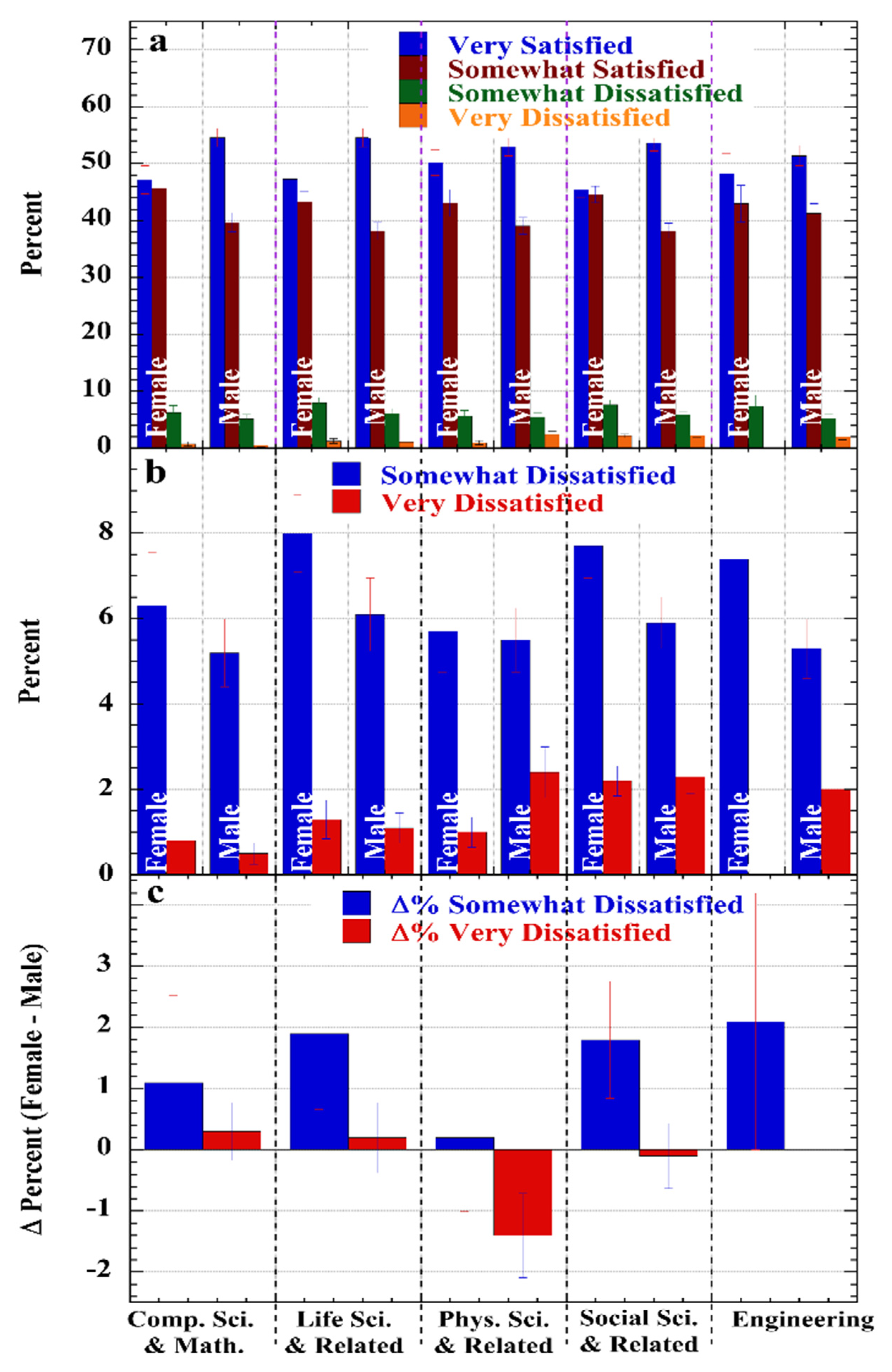
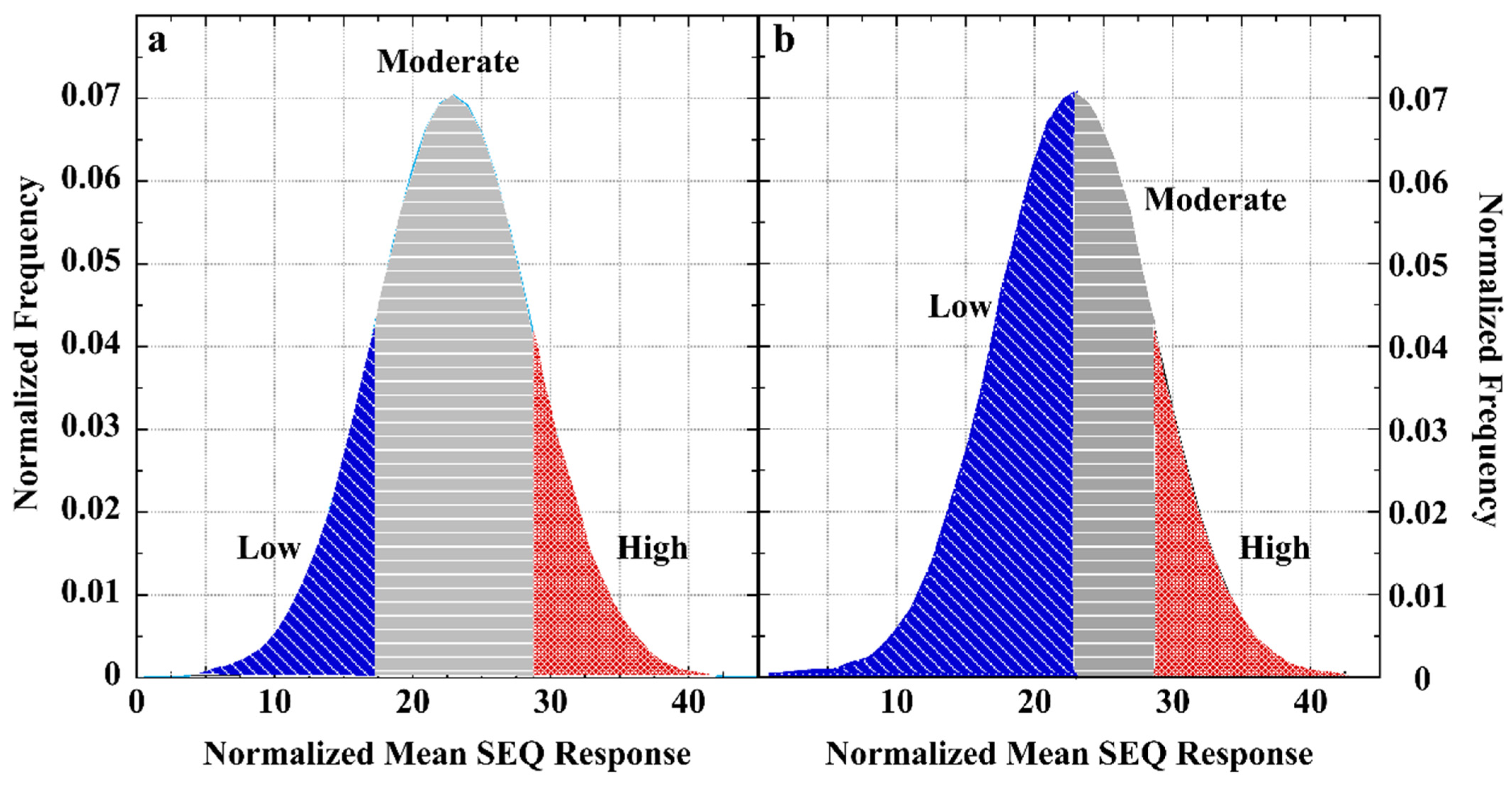
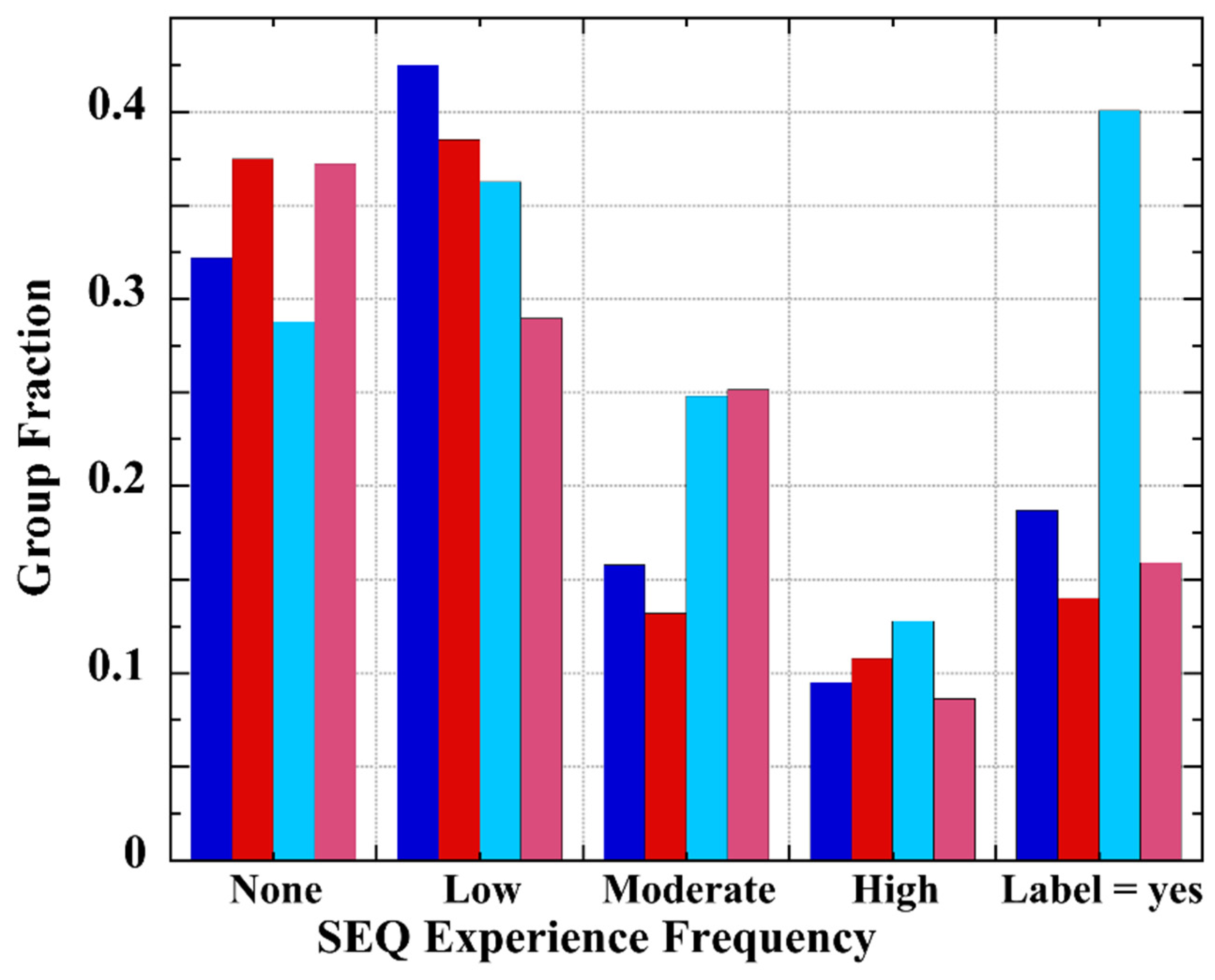
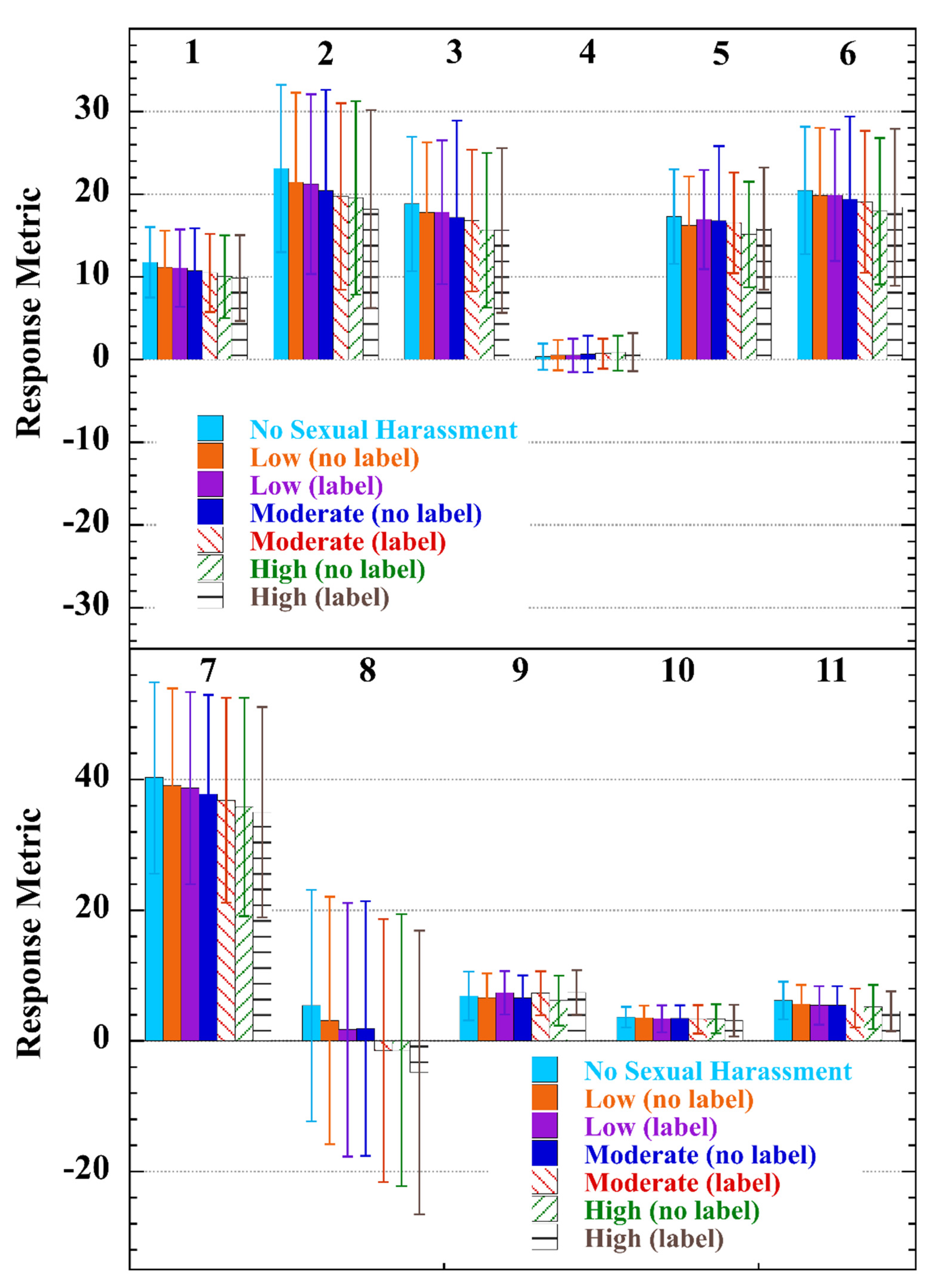
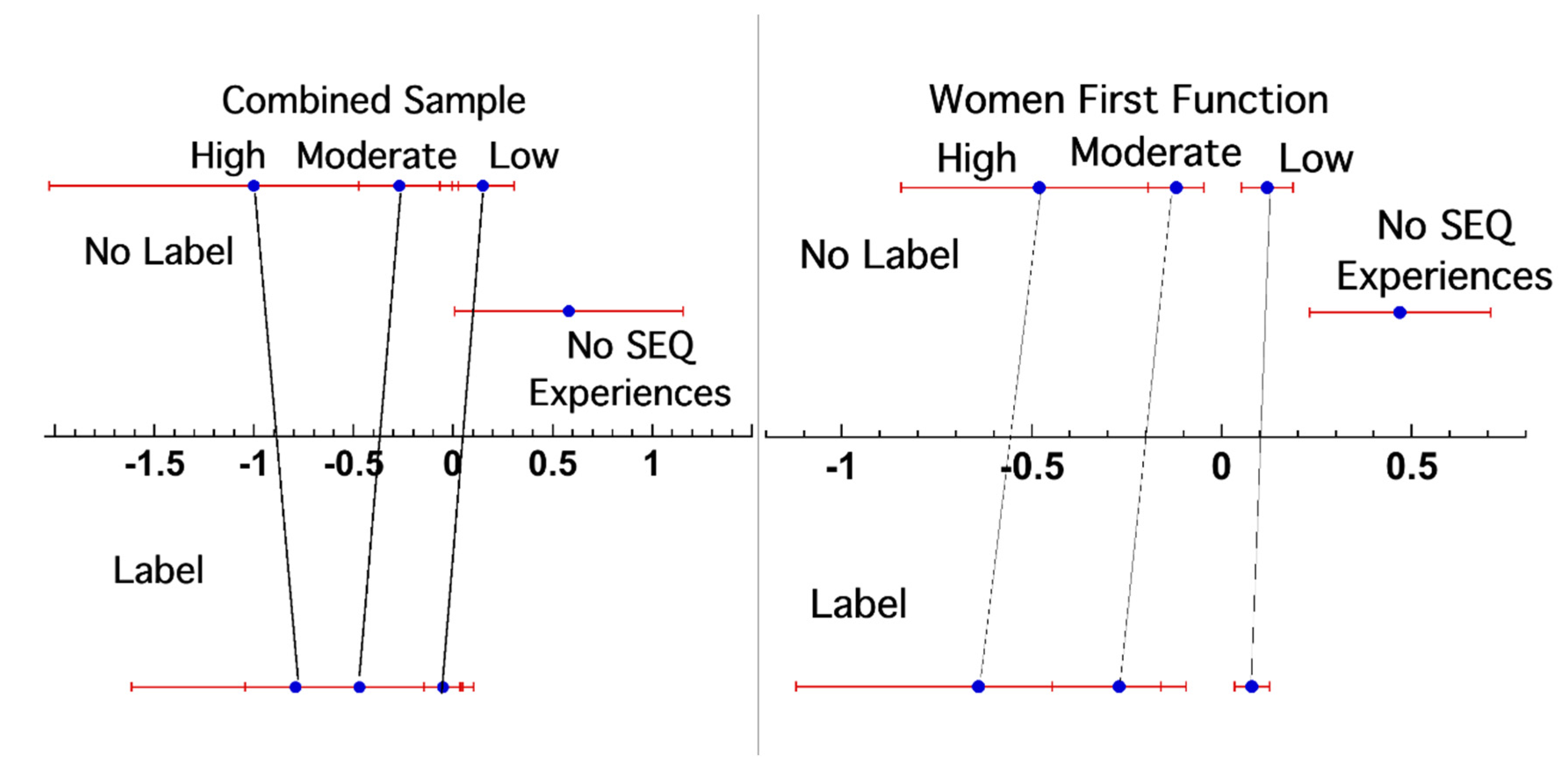
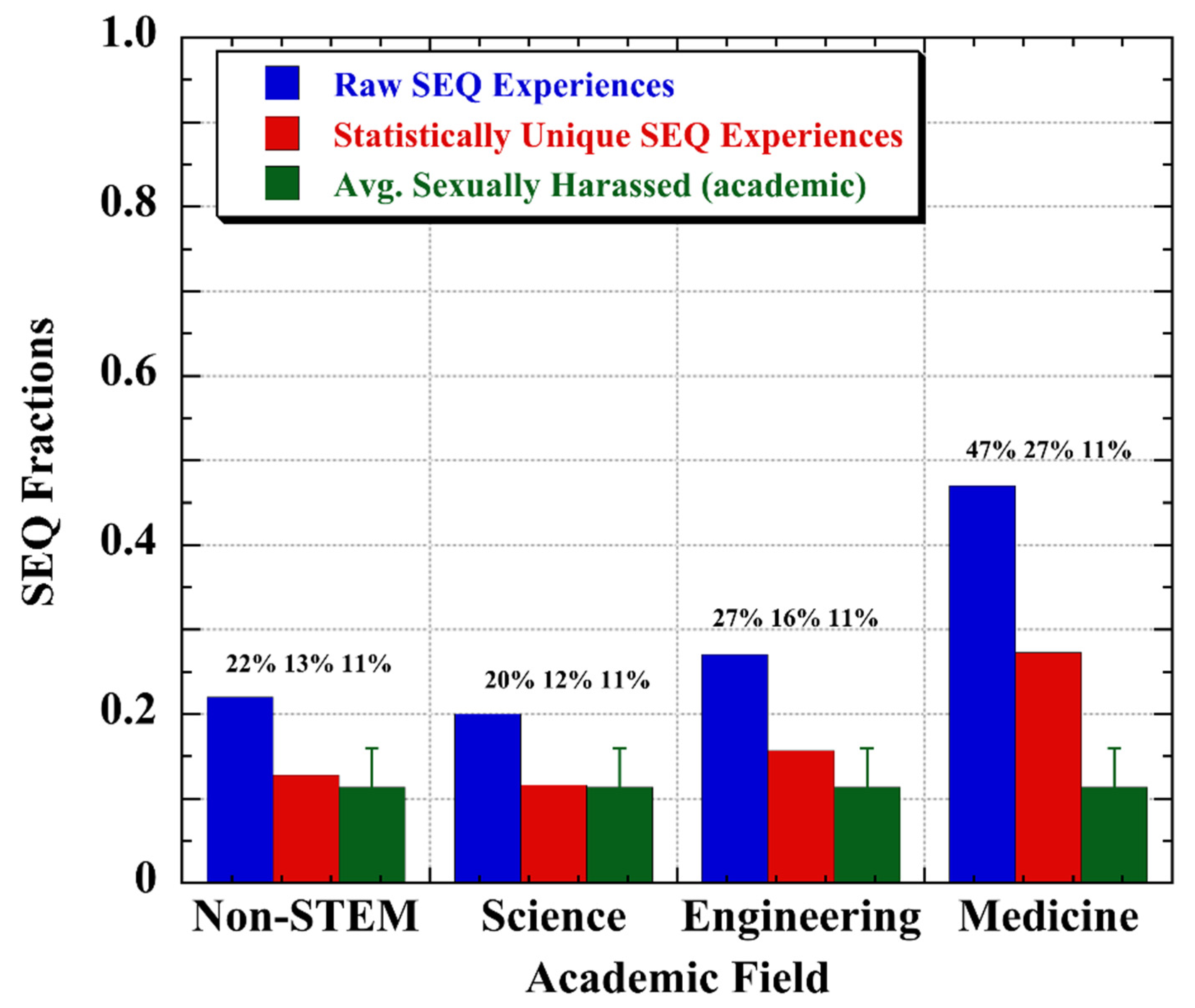
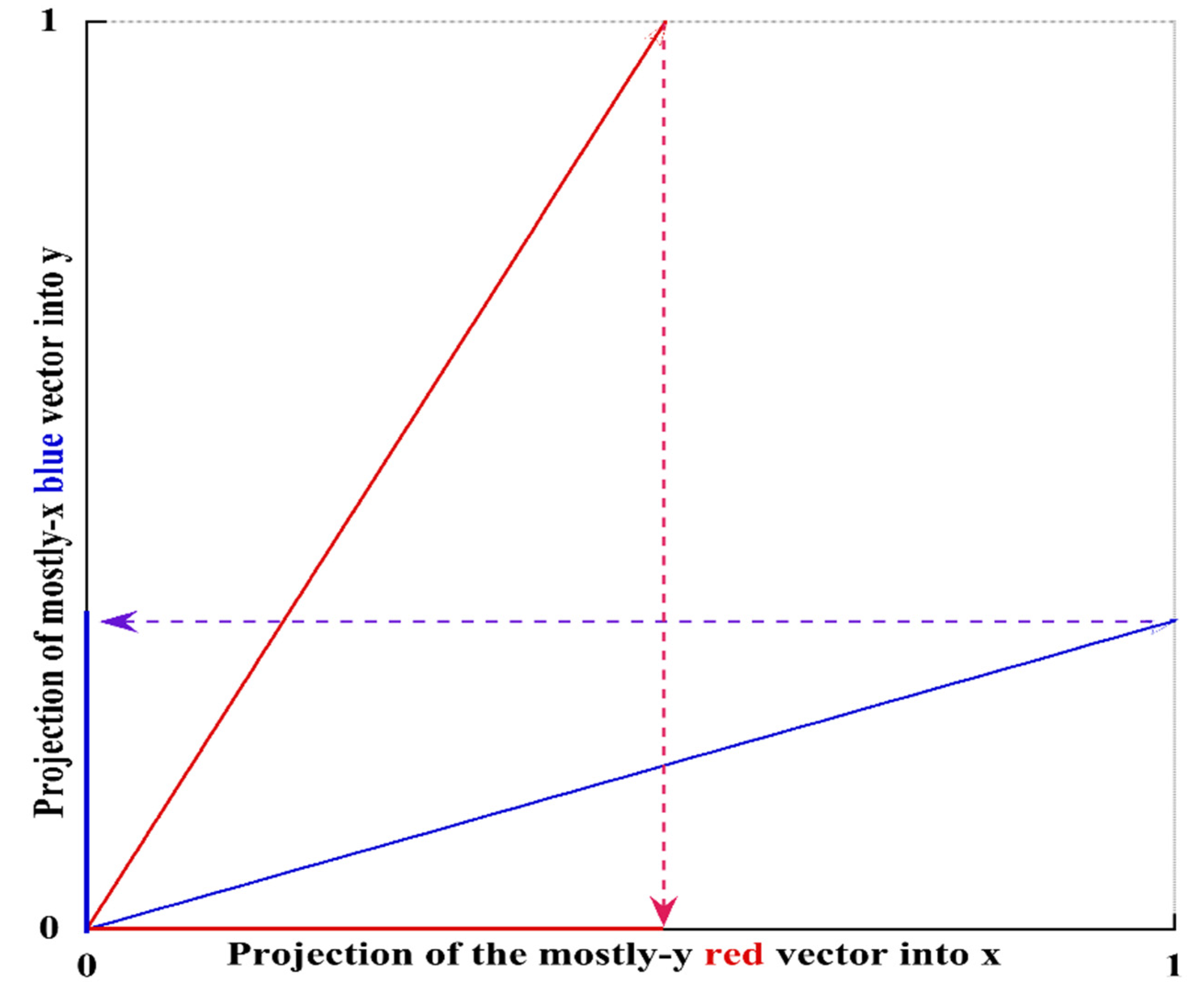
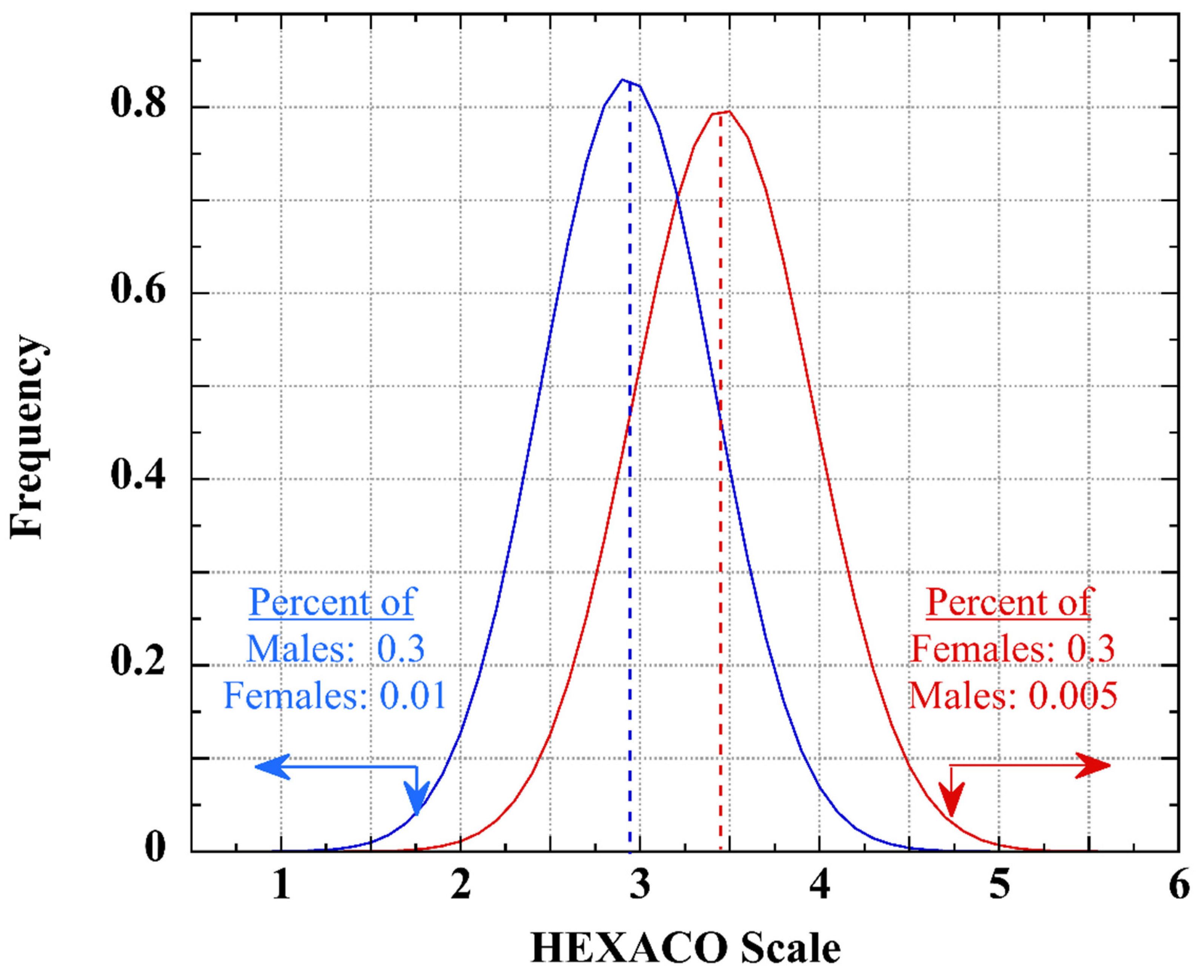
| Field | Female Ph.D.’s 1999–2003 | Applicants Who Were Female | Invited Applicants Who Were Female | First Offers that Went to Females |
|---|---|---|---|---|
| Biology | 45 | 26 | 28 | 34 |
| Chemistry | 32 | 18 | 25 | 29 |
| C. Eng. | 18 | 16 | 30 | 32 |
| E. Eng. | 12 | 11 | 19 | 32 |
| Math. | 25 | 20 | 28 | 32 |
| Physics | 14 | 12 | 19 | 20 |
| % Female Victims a | % Male Offenders b | Time Frame | Reference |
|---|---|---|---|
| 13.4 | 4.7 | Prior to college | [119] c |
| 10.7 | 8 | College | [120] d |
Publisher’s Note: MDPI stays neutral with regard to jurisdictional claims in published maps and institutional affiliations. |
© 2022 by the author. Licensee MDPI, Basel, Switzerland. This article is an open access article distributed under the terms and conditions of the Creative Commons Attribution (CC BY) license (https://creativecommons.org/licenses/by/4.0/).
Share and Cite
Frank, P. Falsification of the Sexual Experiences Questionnaire: No Evidence of Systemic Sexual Harassment in Academic STEM. Psych 2022, 4, 404-434. https://doi.org/10.3390/psych4030034
Frank P. Falsification of the Sexual Experiences Questionnaire: No Evidence of Systemic Sexual Harassment in Academic STEM. Psych. 2022; 4(3):404-434. https://doi.org/10.3390/psych4030034
Chicago/Turabian StyleFrank, Patrick. 2022. "Falsification of the Sexual Experiences Questionnaire: No Evidence of Systemic Sexual Harassment in Academic STEM" Psych 4, no. 3: 404-434. https://doi.org/10.3390/psych4030034
APA StyleFrank, P. (2022). Falsification of the Sexual Experiences Questionnaire: No Evidence of Systemic Sexual Harassment in Academic STEM. Psych, 4(3), 404-434. https://doi.org/10.3390/psych4030034





